1933 New York Canoe Club International Challenge Cup
Hayling Island
Extracts from Gordon K. (Sandy) Douglass "Sixty Years Behind the Mast - The Fox on the Water" and Uffa Fox "Sailing, Seamanship and Yacht Construction"
For further extracts from these volumes see this extract from Uffa's book and this from Gordon Douglass' one.
The American sailing canoes I have been writing about were fine-ended displacement boats which did not truly plane, but rather sliced through the water with a minimum of fuss in the fashion of the modern catamaran hull. They didn't really plane, but with the power provided by the sliding seat they did go a great deal faster than their theoretical hull speed. This, then, is how matters stood at the time we received the challenge from England in 1932 by Uffa Fox and Roger de Quincey.
For about twenty-five years American canoe sailing smugly and contentedly had stayed in the same rut. We had kept the ketch rig although there now was no reason for keeping it, other than its beautiful simplicity of unstayed masts, now that cruising cockpits no longer were used. We used plate centerboards and rudders. There had been slight variations in hull design but no measurable improvement. In 1933 my Nymph was exactly as she was given to me in 1918. She had the same sails, never off the spars, and even the same lacings holding them to the spars. Up to 1933 two seventeen-footers had been built, one of them sailed by Rolf Armstrong, the well-known cover-girl artist of that time. We all used sliding seats and the Norwegian gear with its transverse sliding tiller.
During this time the English had developed their canoes in a different direction. Instead of adopting the sliding seat, as we had, they had developed heavier and beamier boats, boats with so much stability in the hull, plus a heavy ballasted centerboard, that they could be sailed without the sliding seat - but with a lot of hiking, as in the fashion of the early canoes.
The problem facing Uffa Fox, the designer, was - if possible - to design a canoe which would meet both sets of rules, a canoe which would compete well in England and in addition would be competitive under the American rules which would govern the Challenge Cup races.
I have more than a little hesitation in writing about Uffa Fox for fear 1 may not do justice to so important a subject. I have no hesitation in naming him my most unforgettable character. Boat designer, racing skipper, writer, wit, raconteur, singer and friend - he was all of these and more. His influence on the design and development of small sailboats has been felt throughout the sailing world. Whether directly, or indirectly, his work has influenced all subsequent small-boat design.
Behind all of this lay boundless energy and enthusiasm combined with a fertile imagination, good nature and a ready wit. His knowledge of boats, boat design and the sea, was acquired through a long apprenticeship of hard work and experience.
The challenge facing Uffa, then, was to design a canoe which would do well under both the English rules and our rules. A big problem was our rule requiring the sails to be carried on two masts. We intended, and assumed, that this would mean a ketch rig, and this Uffa did not want. The English had long since gone to a sloop rig which they considered to be superior. There were other compromises to be made, but this was a major problem.
How did he solve these problems to give the best features of each and to meet both rules? Uffa solved the mast problem by moving the main mast aft to a normal sloop-rig position, and by putting the mizzenmast into an inclined tube in the bow in such a way that it met, and was attached to, the main mast at its upper end, thus becoming a wooden stay to carry the mizzen sail which now was cut into the form of a jib! But suppose we let Uffa tell the story by quoting part of chapter 11, "Winning the Canoe Championship of America," from his book, "Sailing, Seamanship and Yacht Construction".
"...Then came the designing of our canoes, Roger helping with letters, full of ideas, from Trinity (Oxford Univ.), and finally the canoes were designed to both sets of rules.
"The American maximum beam rule forced us to design canoes 3 in. narrower than the English rule, whilst the English rule, demanding a 1/4 in. planking, forced our hulls 40 lbs. over the minimum weight allowed in America.
"Time alone would tell if we could afford to give away the 3 in. of beam under the English rule, where no sliding seat was allowed, and carry the extra 40 lb. of weight around the American courses, but we thought we might, and it was worth trying.
"The rig would have to be different, as entirely different rules prevailed. Under the American rule, we were allowed 111 sq. ft. of sail, actual area, with a height of 16 ft., but no side stays on the mast, while under the English rule we were allowed 96 sq. ft., Y.R.A. measurement, with no restriction as to height or staying of mast.
"The Americans had no limit to the depth of centerboard, so while racing there, we thought we would try a very deep one, which was impossible under the English rule, which only allowed a board to extend 1 metre below the canoe. The American rules allowed a sliding seat, and the English did not, so by changing rigs and drop keels, and adding a sliding seat, our canoes were changed from the English to the American rules.
"The American rule allowing a sliding seat, but no side stays, made a fair amount of work calculating the leverage and power exerted by a man five foot out on a slide, plus the power of the canoe and balancing this against the strength and elasticity of hollow spruce spars. For, to win races, weight, and so strength, must be cut down to its limit, yet to carry away a spar is fatal.
"After the designing came the building. VALIANT and EAST ANGLIAN were built upside down, for the bottom of any vessel is the part that decides her speed, and by building upside down this is always in view."
The English canoes did, indeed, look strange to our eyes when first we saw them. We couldn't help but admire the superb craftsmanship with which they were built, so near to perfection, and the mirror-like shine of their varnish finish. But to us they were the antithesis of the boats we knew. The sloop rig alone was enough of a change from the look of our canoes, but where our boats were slender and dainty, with fine sharp ends, the English canoes appeared squat, giving the impression of brute power. Where our canoes had softly rounded bilges for a minimum of wetted surface but little stability, theirs were almost flat in the bottom with very hard bilges. Our power to carry sail was provided entirely by our live ballast out on the sliding seat. Fully rigged, our canoes had so little stability they would not even stand upright, but had to be balanced at all times. Their canoes, developed for heavy weather, sailing without the advantage of sliding seats, had their own stability through greater beam with a flat floor and hard bilges, plus a heavy and deep centerboard. Uffa had gone as far as possible to use the maximum beam permitted under our rules, forty-three inches, by carrying the full beam very nearly the length of the hull, to where the gunwales, as they came together at the stern, made an angle of more than ninety degrees. The bow also was very full at the deck.
Forced to it by the English rules, Uffa had built these boats with open cockpits, with splashboards on the bow deck to help to shed water. The four and one-half foot length of the cockpit makes me think that sometimes in heavy weather these boats perhaps were sailed by a crew of two. Other great differences were in the underbody rudders, shipped through a rudder trunk through the stern deck, and the heavy and deep cast bronze centerboard, heavy enough to require a winch, and very carefully polished to a beautifully streamlined shape. This board, drawing four feet nine inches, was in great contrast to our shallow and wide aluminum plate centerboards drawing about three feet. We always had used stern rudders controlled by our Norwegian gear with its sliding transverse tiller, but the English, who preferred a regular tiller, had found that a stern rudder would require a six-foot tiller, too long to be practical, and for that reason had moved the rudder nearly three feet forward of the stern, but removable through the rudder trunk.
With so many differences in design of hull, rigging and sails, with the English canoes having been modified to meet our rules, we all - we and they - naturally were interested in learning how they would compare with ours around the race triangle. With the greater weight and, to us, the clumsy appearance of the English boats in mind, our thoughts went back to the early challenges of the past century when our canoes left the English far behind. To our great surprise, it very soon became apparent that in light winds we were about even, that with any weight of wind they were faster, and that it was only in a drifter that we had an advantage.
My greatest surprise and awakening came in one of the first tune-up races. I had rounded the leeward mark ahead of Roger deQuincey in Valiant. On the Sugar Island race course the fixed starting line is at the corner of the triangle nearest Sugar Island, meaning that in the prevailing southwest wind this gives a reaching start with two reaching legs in advance of the windward leg. In the light-medium breeze we had sailed about even on the reaches, and as soon as we hardened down for the beat I commenced to pull away from Roger. For a few minutes it looked like a walkaway. But when I tacked to cover him I was shocked to discover that he had pointed so much higher, at least a point higher, and had eaten up to windward to such an extent that I had to cross well behind his stern. His deep and efficient centerboard and his bluff lee bow had helped him to eat up into the wind, and this was to be pretty much the story of the races.
The races, THE races, for the International Challenge Cup were scheduled to be sailed on Flushing Bay, Long Island, two weeks later. My father and I considered my going down for the selection races which would determine the defenders of the cup, but knowing, all too well, the members of the Selection Committee - with some of whom we were not on the friendliest terms - we decided that it would be futile for me to take my Nymph there. We had no confidence that I would be one of those selected, and as it turned out, the committee decided that the results of the trial races were inconclusive and arbitrarily named Leo Friede and Walter Busch. Friede, sailing his Mermaid, was one of our best sailors. In the past he had twice successfully defended the cup against Canadian challengers. Walter Busch, sailing Loon, was an unknown.
The outcome of the Challenge Cup races probably would have been no different had I been a defender. The Americans won the first race in light airs. To Uffa's surprise, the triangle set by the cornmittee was such that one leg was a dead run and the other two were reaches, giving none of the windward work at which the English excelled.
The second race started with a flat calm, but after a postponement a fresh breeze came in exactly opposite in direction to the one of the day before, and this gave a triangle with a good beat. Valiant led all the way, with East Anglian covering and serving as rear guard over Mermaid and Loon.
The Race Committee spared no efforts in giving the American team every advantage, and Uffa comments, "The morning of the final race was just what the doctor had ordered for us, as a strong wind was blowing from exactly the same quarter as the day before, and we imagined we should be sent around the triangle the same way, but as we approached the Committee Boat, running dead before the wind, we were surprised to see the signals hoisted for a course the opposite way around. So we started with a dead run to the lee mark, with no chance of a windward leg, unless the wind shifted." This time, East Anglian led each round, with Valiant covering Mermaid and Loon, until Mermaid's mizzen sheet broke (What! and after only ten years' use? How ridiculous to be so ill-prepared for a match like this!) and Mermaid retired. This is how, after forty-eight years, the Challenge Cup and the Sailing Trophy were taken to England in 1933.
After the noise and hoopla had died away and the dust had settled, we and the English realized that each had learned from the other, and that all would profit from combining our thinking and drawing up rules under which we could operate together. Such rules, of course, would require concessions on each side, but by using the best features of each we should develop a better boat. This is what came of it. The English adopted our sliding seat and self-bailing cockpit, and English designers, with Uffa leading the way, went to the easier hull lines and lighter centerboards which were made practical by the sliding seat. We, however, appear to have learned little, other than that a seventeen-foot boat had greater potential than had a sixteen-thirty. As a matter of fact, we did little or nothing in the next several years other than to adopt the new rules which permitted a sloop rig with a maximum sail area of ten square meters but no one tried a sloop rig.
"Sixty Years Behind the Mast - The Fox on the Water" Gordon K. (Sandy) Douglass
"Sailing, Seamanship and Yacht Construction" by Uffa Fox
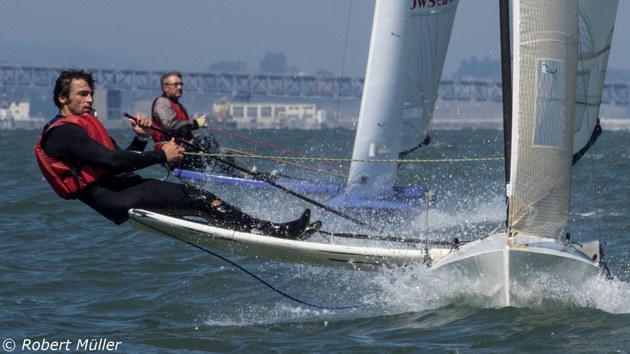
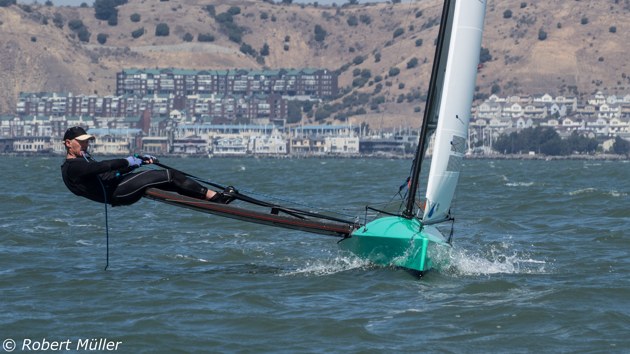
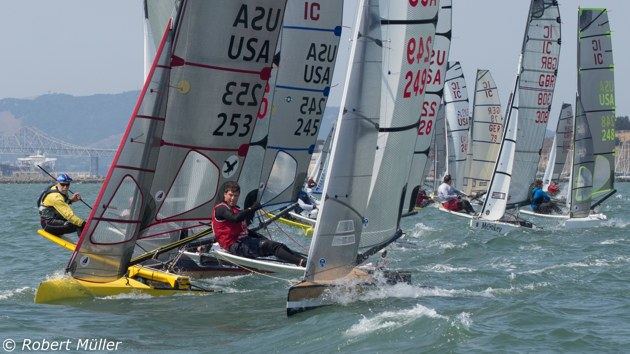
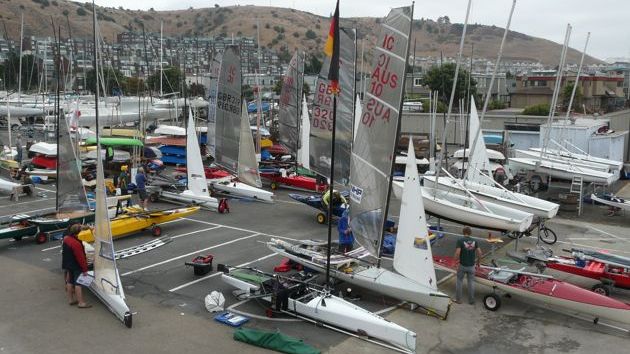



Ulrike_veerkamp.jpg)
Ulrike_veerkamp.jpg)

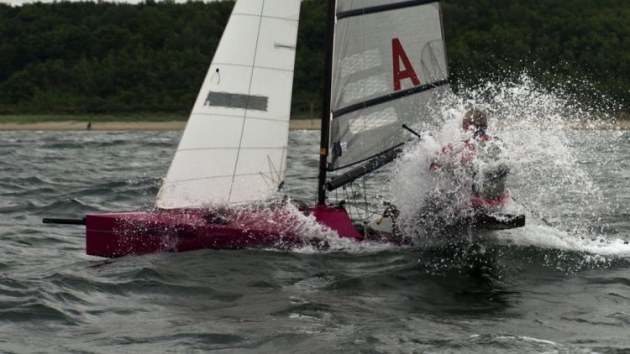
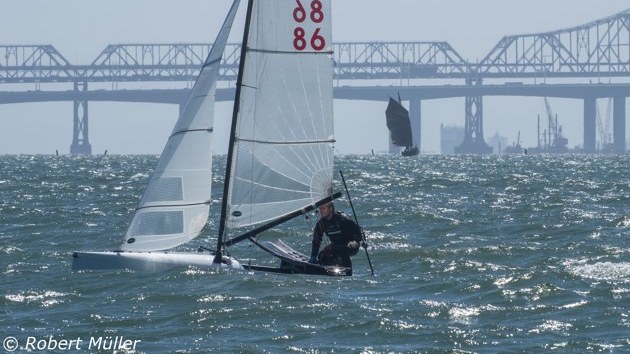
Ulrike_veerkamp.jpg)